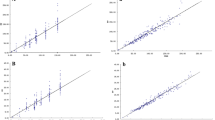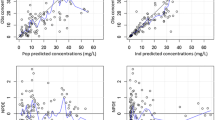Abstract
Background
Critically ill children frequently display observed alterations of pharmacokinetic (PK) parameters, leading to a reduction in β-lactam concentrations. This study aimed to develop a PK population model for piperacillin in order to optimize individual dosing regimens.
Methods
All children aged ≤ 18 years, weighing more than 2.5 kg, and receiving piperacillin infusions were included in this study. Piperacillin was quantified by high-performance liquid chromatography, and PK were described using the non-linear mixed-effect modeling software MONOLIX. Monte Carlo simulations were used to optimize dosing regimens in order to attain two PK targets: 50% fT>MIC and 100% fT>MIC.
Results
We included 50 children with a median (range) postnatal age of 2.3 years (0.1–18), body weight (BW) of 11.9 kg (2.7–50), Pediatric Logistic Organ Dysfunction-2 (PELOD-2) severity score of 4 (0–16), and estimated glomerular filtration rate (eGFR) of 142 mL.min−1.1.73 m−2 (29–675). A one-compartment model with first-order elimination adequately described the data. Median (range) values for piperacillin clearance (CL) and volume of distribution were 3 L.h−1 (0.71–10) and 0.33 L.kg−1 (0.21–0.86), respectively. BW was integrated with the allometric relationship. eGFR and PELOD-2 severity score were the covariates explaining between-subject variability in CL and volume, respectively. According to the simulations, extended and continuous infusion provided the highest probability of reaching the target of 50% fT>MIC and 100% fT>MIC for normal and augmented renal clearance, respectively.
Conclusions
Unlike standard intermittent piperacillin dosing regimens, extended and continuous infusion allows the PK targets to be reached, for children with normal or augmented renal clearance.
Trial Registration Number
Registered at http://www.clinicaltrials.gov (NCT02539407).




Similar content being viewed by others
References
Amadeo B, Zarb P, Muller A, Drapier N, Vankerckhoven V, Rogues A-M, et al. European Surveillance of Antibiotic Consumption (ESAC) point prevalence survey 2008: paediatric antimicrobial prescribing in 32 hospitals of 21 European countries. J Antimicrob Chemother. 2010;65:2247–52.
Blinova E, Lau E, Bitnun A, Cox P, Schwartz S, Atenafu E, et al. Point prevalence survey of antimicrobial utilization in the cardiac and pediatric critical care unit. Pediatr Crit Care Med. 2013;14:e280–8.
Versporten A, Bielicki J, Drapier N, Sharland M, Goossens H. The worldwide Antibiotic Resistance and Prescribing in European Children (ARPEC) point prevalence survey: developing hospital-quality indicators of antibiotic prescribing for children. J Antimicrob Chemother. 2016;71:1106–17.
Drusano GL. Antimicrobial pharmacodynamics: critical interactions of “bug and drug”. Nat Rev Microbiol. 2004;2:289–300.
Huttner A, Harbarth S, Hope WW, Lipman J, Roberts JA. Therapeutic drug monitoring of the β-lactam antibiotics: what is the evidence and which patients should we be using it for? J Antimicrob Chemother. 2015;70:3178–83.
Mouton JW, Vinks AA. Continuous infusion of beta-lactams. Curr Opin Crit Care. 2007;13:598–606.
Roberts JA, Paul SK, Akova M, Bassetti M, De Waele JJ, Dimopoulos G, et al. DALI: defining antibiotic levels in intensive care unit patients: are current β-lactam antibiotic doses sufficient for critically ill patients? Clin Infect Dis. 2014;58:1072–83.
Chen Y, Lu J, Dong M, Wu D, Zhu Y, Li Q, et al. Target attainment analysis and optimal sampling designs for population pharmacokinetic study on piperacillin/tazobactam in neonates and young infants. Eur J Clin Pharmacol. 2016;72:1479–88.
Lau WK, Mercer D, Itani KM, Nicolau DP, Kuti JL, Mansfield D, et al. Randomized, open-label, comparative study of piperacillin-tazobactam administered by continuous infusion versus intermittent infusion for treatment of hospitalized patients with complicated intra-abdominal infection. Antimicrob Agents Chemother. 2006;50:3556–61.
Aardema H, Nannan Panday P, Wessels M, van Hateren K, Dieperink W, Kosterink JGW, et al. Target attainment with continuous dosing of piperacillin/tazobactam in critical illness: a prospective observational study. Int J Antimicrob Agents. 2017;50:68–73.
Thakkar N, Salerno S, Hornik CP, Gonzalez D. Clinical pharmacology studies in critically ill children. Pharm Res. 2017;34:7–24.
Blot SI, Pea F, Lipman J. The effect of pathophysiology on pharmacokinetics in the critically ill patient: concepts appraised by the example of antimicrobial agents. Adv Drug Deliv Rev. 2014;77:3–11.
Roberts JA, Lipman J. Pharmacokinetic issues for antibiotics in the critically ill patient. Crit Care Med. 2009;37:840–51.
De Cock PAJG, van Dijkman SC, de Jaeger A, Willems J, Carlier M, Verstraete AG, et al. Dose optimization of piperacillin/tazobactam in critically ill children. J Antimicrob Chemother. 2017;72:2002–11.
Nichols K, Chung EK, Knoderer CA, Buenger LE, Healy DP, Dees J, et al. Population pharmacokinetics and pharmacodynamics of extended-infusion piperacillin and tazobactam in critically ill children. Antimicrob Agents Chemother. 2016;60:522–31.
Cies JJ, Shankar V, Schlichting C, Kuti JL. Population pharmacokinetics of piperacillin/tazobactam in critically ill young children. Pediatr Infect Dis J. 2014;33:168–73.
Alobaid AS, Wallis SC, Jarrett P, Starr T, Stuart J, Lassig-Smith M, et al. Population pharmacokinetics of piperacillin in nonobese, obese, and morbidly obese critically ill patients. Antimicrob Agents Chemother. 2017;61:e01276.
Tsai D, Stewart P, Goud R, Gourley S, Hewagama S, Krishnaswamy S, et al. Pharmacokinetics of piperacillin in critically ill Australian Indigenous patients with severe sepsis. Antimicrob Agents Chemother. 2016;60:7402–6.
Roberts JA, Boots R, Rickard CM, Thomas P, Quinn J, Roberts DM, et al. Is continuous infusion ceftriaxone better than once-a-day dosing in intensive care? A randomized controlled pilot study. J Antimicrob Chemother. 2007;59:285–91.
Goldstein B, Giroir B, Randolph A. International pediatric sepsis consensus conference: definitions for sepsis and organ dysfunction in pediatrics. Pediatr Crit Care Med. 2005;6:2–8.
Leteurtre S, Duhamel A, Salleron J, Grandbastien B, Lacroix J, Leclerc F. PELOD-2: an update of the PEdiatric Logistic Organ Dysfunction Score. Crit Care Med. 2013;41:1761–73.
Schwartz G, Brion L, Spitzer A. The use of plasma creatinine concentration for estimating glomerular filtration rate in infants, children, and adolescents. Pediatr Clin N Am. 1987;34:571–90.
European Committee on Antimicrobial Susceptibility Testing (EUCAST). Antimicrobial wild type distributions of microorganisms, piperacillin-tazobactam. https://mic.eucast.org/Eucast2/SearchController/search.jsp?action=performSearch&BeginIndex=0&Micdif=mic&NumberIndex=50&Antib=251&Specium=-1. Accessed 1 Apr 2018.
Food and Drug Administration, Center for Drug Evaluation and Research. Guidance for Industry, Bioanalytical method validation. https://www.fda.gov/downloads/Drugs/Guidance/ucm070107.pdf. Accessed 1 Apr 2018.
Anderson BJ, Holford NHG. Mechanism-based concepts of size and maturity in pharmacokinetics. Annu Rev Pharmacol Toxicol. 2008;48:303–32.
Drug Bank. FDA Professional Drug Information. Piperacillin. https://www.drugs.com/pro/piperacillin-and-tazobactam.html. Accessed 1 Apr 2018.
European Medicines Agency. Committee for Medicinal Products for Human Use (CHMP) assessment report pursuant to Article 30 of Directive 2001/83/EC, as amended for Tazocin and associated names (INN: piperacillin-tazobactam). http://www.ema.europa.eu/docs/en_GB/document_library/Referrals_document/Tazocin_30/WC500154789.pdf. Accessed 1 Apr 2018.
Tornøe CW, Tworzyanski JJ, Imoisili MA, Alexander JJ, Korth-Bradley JM, Gobburu JVS. Optimising piperacillin/tazobactam dosing in paediatrics. Int J Antimicrob Agents. 2007;30:320–4.
Rhodin MM, Anderson BJ, Peters AM, Coulthard MG, Wilkins B, Cole M, et al. Human renal function maturation: a quantitative description using weight and postmenstrual age. Pediatr Nephrol. 2009;24:67–76.
Padgett D, Ostrenga A, Lepard L. Comparison of methods of estimating creatinine clearance in pediatric patients. Am J Health Syst Pharm. 2017;74:826–30.
Filler G, Yasin A, Medeiros M. Methods of assessing renal function. Pediatr Nephrol. 2014;29:183–92.
Nakhjavan-Shahraki B, Yousefifard M, Ataei N, Baikpour M, Ataei F, Bazargani B, et al. Accuracy of cystatin C in prediction of acute kidney injury in children; serum or urine levels: which one works better? A systematic review and meta-analysis. BMC Nephrol. 2017;17:120.
Mian AN, Schwartz GJ. Measurement and estimation of glomerular filtration rate in children. Adv Chron Kidney Dis. 2017;24:348–56.
Udy AA, Roberts JA, Boots RJ, Paterson DL, Lipman J. Augmented renal clearance: implications for antibacterial dosing in the critically ill. Clin Pharmacokinet. 2010;49:1–16.
Avedissian SN, Bradley E, Zhang D, Bradley JS, Nazer LH, Tran TM, et al. Augmented renal clearance using population-based pharmacokinetic modeling in critically ill pediatric patients. Pediatr Crit Care Med. 2017;18:e388–94.
Udy AA, Putt MT, Boots RJ, Lipman J. ARC—augmented renal clearance. Curr Pharm Biotechnol. 2011;12:2020–9.
De Cock PAJG, Standing JF, Barker CIS, de Jaeger A, Dhont E, Carlier M, et al. Augmented renal clearance implies a need for increased amoxicillin-clavulanic acid dosing in critically ill children. Antimicrob Agents Chemother. 2015;59:7027–35.
Lee B, Kim J, Park JD, Kang HM, Cho YS, Kim KS. Predicting augmented renal clearance using estimated glomerular filtration rate in critically-ill children. Clin Nephrol. 2017;88:148–55.
Carlier M, Carrette S, Roberts JA, Stove V, Verstraete A, Hoste E, et al. Meropenem and piperacillin/tazobactam prescribing in critically ill patients: does augmented renal clearance affect pharmacokinetic/pharmacodynamic target attainment when extended infusions are used? Crit Care. 2013;17:R84.
Delvallée M, Mazingue F, Abouchahla W, Delebarre M, Wallet F, Courcol R, et al. Optimization of continuous infusion of piperacillin-tazobactam in children with fever and neutropenia. Pediatr Infect Dis J. 2013;32:962–4.
Blondiaux N, Wallet F, Favory R, Onimus T, Nseir S, Courcol RJ, et al. Daily serum piperacillin monitoring is advisable in critically ill patients. Int J Antimicrob Agents. 2010;35:500–3.
Conil J-M, Georges B, Mimoz O, Dieye E, Ruiz S, Cougot P, et al. Influence of renal function on trough serum concentrations of piperacillin in intensive care unit patients. Intensive Care Med. 2006;32:2063–6.
Yang H, Cui X, Ma Z, Liu L. Evaluation outcomes associated with alternative dosing strategies for piperacillin/tazobactam: a systematic review and meta-analysis. J Pharm Sci. 2016;19:274–89.
Goldstein EJC, Falagas ME, Tansarli GS, Ikawa K, Vardakas KZ. Clinical outcomes with extended or continuous versus short-term intravenous infusion of carbapenems and piperacillin/tazobactam: a systematic review and meta-analysis. Clin Infect Dis. 2013;56:272–82.
Acknowledgements
The authors thank the PICU team (physicians and nurses) that selected the children and collected the samples, making this work possible. They also thank the pharmacology laboratory of the Cochin Teaching Hospital, which analyzed the samples. Agathe Béranger received a grant from the Agence Régionale de Santé Ile-de-France for a 1-year research fellowship in the EA7323.
Author information
Authors and Affiliations
Corresponding author
Ethics declarations
Conflict of interest
Agathe Béranger, Sihem Benaboud, Saïk Urien, Florence Moulin, Emmanuelle Bille, Fabrice Lesage, Yi Zheng, Mathieu Genuini, Inès Gana, Sylvain Renolleau, Déborah Hirt, Jean-Marc Tréluyer, and Mehdi Oualha declare no conflicts of interest.
Funding
The research study did not receive funds or support from any source.
Informed Consent
Informed consent was obtained from all parents of the children included in the study.
Electronic supplementary material
Below is the link to the electronic supplementary material.
40262_2018_682_MOESM1_ESM.tif
Probability of target attainment (100% fT>MIC in blue and 50% fT>MIC in green) according to our dosing regimen (DR), European (EMA) and American (FDA) assessments. (TIFF 1783 kb)
40262_2018_682_MOESM2_ESM.tiff
Probability of target attainment obtained from 1200 simulations for each body weight, for continuous infusion and a target defined as 100% fT>MIC. Four groups were defined according to renal function (a and c for augmented, and b and d for normal) and PELOD-2 severity score (a and b if < 5, and c and d if ≥ 5). Daily dosing regimens were defined according to renal function: 400 mg.kg−1.day−1 for augmented, 300 mg.kg−1.day−1 for normal. (TIFF 1341 kb)
40262_2018_682_MOESM3_ESM.tiff
Concentrations versus time courses for augmented renal clearance (eGFR > 130 mL.min−1.1.73 m−2), for PELOD-2 score < 5, depending on the different simulated administrations, for a daily dosing regimen of 400 mg.kg−1.day−1. The thick line depicts the median, the dashed lines are the 25th and 75th interquartile, and the dotted lines are the 95th confidence interval. The grey horizontal lines are the inferior (16 mg.L−1) and superior (150 mg.L−1) concentration targets, respectively. (TIFF 1565 kb)
40262_2018_682_MOESM4_ESM.tiff
Concentrations versus time courses for normal renal function (eGFR 40-130 mL.min−1.1.73 m−2), for PELOD-2 score < 5, depending on the different simulated administrations, for a daily dosing regimen of 300 mg.kg−1.day−1. The thick line depicts the median, the dashed lines are the 25th and 75th interquartile, and the dotted lines are the 95th confidence interval. The grey horizontal lines are the inferior (16 mg.L−1) and superior (150 mg.L−1) concentrations target, respectively. (TIFF 1565 kb)
Rights and permissions
About this article
Cite this article
Béranger, A., Benaboud, S., Urien, S. et al. Piperacillin Population Pharmacokinetics and Dosing Regimen Optimization in Critically Ill Children with Normal and Augmented Renal Clearance. Clin Pharmacokinet 58, 223–233 (2019). https://doi.org/10.1007/s40262-018-0682-1
Published:
Issue Date:
DOI: https://doi.org/10.1007/s40262-018-0682-1




